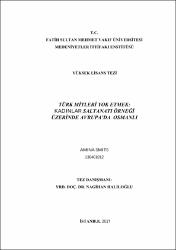| dc.contributor.advisor | Haliloğlu, Nagihan | |
| dc.contributor.author | Smits, Amina | |
| dc.date.accessioned | 2017-03-15T11:11:01Z | |
| dc.date.available | 2017-03-15T11:11:01Z | |
| dc.date.issued | 2017 | |
| dc.date.submitted | 2017 | |
| dc.identifier.citation | SMITS, Amina, Türk Mitleri Yok Etmek : Kadınlar Saltanatı Örneği Üzerinde Avrupa’da Osmanlı, Fatih Sultan Mehmet Vakıf Üniversitesi Medeniyetler İttifakı Enstitüsü Medeniyet Araştırmaları Anabilim Dalı, Yayımlanmamış Yüksek Lisans Tezi, İstanbul 2017 | en_US |
| dc.identifier.uri | https://hdl.handle.net/11352/2450 | |
| dc.description.abstract | Bu tezde “Kadınlar Saltanatı” olarak bilinen dönemdeki karmaĢık Osmanlı-Avrupa
iliĢkilerine Edward Said‟in Oryantalizm adlı eserinin ve “Türk Miti”nin ıĢığında
yakından bakılacaktır. Bu süreçte, bu iliĢkilerin Said‟in iddia ettiğinden daha da
karmaĢık olduğunu ve, tekerrür eden olumsuz imajlara rağmen Osmanlılar hakkında,
Avrupa‟da yaygın Ģekilde birçok olumlu görüĢlerin de olduğunu gözler önüne
sermeyi ve dolayısıyla yalnızca Batı cephesinin Osmanlılar hakkındaki önyargıları
değil, aynı zamanda Doğu‟da Batı-karĢıtı fikirleri de aĢmayı hedeflenmektedir.
Bunun için ise, öncelikle bu dönemin ve politik aktörlerinin önemini göstermek için
“Kadınlar Saltanatı” yakından incelenecektir. Çoğu zaman Batılı yazarlardan istifade
edilerek, bu dönem boyunca meydana gelen tarihi olaylar , ve özellikle Harem-i
Hümayun, Doğu Despotu ve Barbar Türk mitleri hakkında yazılan eserlerin
incelenerek aslında Avrupalıların Osmanlılar hakkında yazabileceklerini, yazılan her
eserin emperyalist düĢüncenin bir parçası olmadığını ispat etmeyi amaçlamaktadır. | en_US |
| dc.description.abstract | In this thesis, I will take a closer look at the complex relationship between the
Ottoman Empire and Europe during the period that is known as the “Sultanate of
Women” in the light of Edward Said‟s Orientalism and the “Turkish Myth”. Through
this, I aim to illustrate that these relationships were far more complex than Said
would have us believe and that, despite a recurring negative image, there were also
many positive reports on the Ottomans circulating Europe, thus breaking through not
only prejudices on the Ottomans from the Western front, but also anti-Western
sentiments in the East. In order to do so, I will first examine the “Sultanate of
Women” up close to show the significance of this period and its political actors.
Furthermore, I will be recounting historical events throughout this period, mainly
from Western perspective throughout several chapters dealing with the myths of the
Royal Harem, Oriental Despotism and the Barbaric Turk to prove that Europeans
were indeed able to write on the Ottomans and that not all that was written on the
Orient should be regarded as a yet another work to serve Colonialist goals. | en_US |
| dc.language.iso | tur | en_US |
| dc.publisher | Fatih Sultan Mehmet Vakıf Üniversitesi, Medeniyetler İttifakı Enstitüsü | en_US |
| dc.rights | info:eu-repo/semantics/openAccess | en_US |
| dc.subject | Edward Said | en_US |
| dc.subject | Oryantalizm | en_US |
| dc.subject | Kadınlar Saltanatı | en_US |
| dc.subject | Diplomatik İlişkiler | en_US |
| dc.subject | Harem | en_US |
| dc.subject | Osmanlılar | en_US |
| dc.subject | Doğu Despot | en_US |
| dc.subject | Orientalism | en_US |
| dc.subject | Sultanate of Women | en_US |
| dc.subject | Diplomatic Relations | en_US |
| dc.subject | Ottomans | en_US |
| dc.subject | Oriental Despot | en_US |
| dc.title | Türk Mitleri Yok Etmek : Kadınlar Saltanatı Örneği Üzerinde Avrupa’da Osmanlı | en_US |
| dc.type | masterThesis | en_US |
| dc.contributor.department | FSM Vakıf Üniversitesi, Medeniyetler İttifakı Enstitüsü | en_US |
| dc.relation.publicationcategory | Tez | en_US |
| dc.contributor.institutionauthor | Smits, Amina | |



















